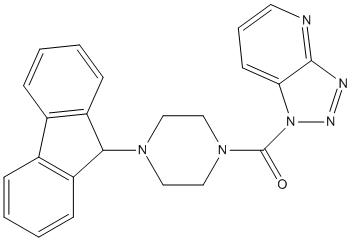AM6580
urea-based inhibitor AM6580 (hMAGL IC(50) 3 nM) (ratFAAH IC50 10.7 nM)
General
Type : Piperazine,Piperidine,Fluoren,Triazol,Urea derivative
Chemical_Nomenclature : [4-(9~{H}-fluoren-9-yl)piperazin-1-yl]-(triazolo[4,5-b]pyridin-1-yl)methanone
Canonical SMILES : C1CN(CCN1C2C3=CC=CC=C3C4=CC=CC=C24)C(=O)N5C6=C(N=CC=C6)N=N5
InChI : InChI=1S\/C23H20N6O\/c30-23(29-20-10-5-11-24-22(20)25-26-29)28-14-12-27(13-15-28)21-18-8-3-1-6-16(18)17-7-2-4-9-19(17)21\/h1-11,21H,12-15H2
InChIKey : FZFRAGWORHDDSR-UHFFFAOYSA-N
Other name(s) : SCHEMBL915560,AM-6580
MW : 396.45
Formula : C23H20N6O
CAS_number :
PubChem : 25096356
UniChem : FZFRAGWORHDDSR-UHFFFAOYSA-N
IUPHAR :
Wikipedia :

Target
Families : AM6580 ligand of proteins in family: Monoglyceridelipase_lysophospholip
Stucture :
Protein : human-MGLL
References (5)
| Title : Inhibition of triple negative breast cancer-associated inflammation, tumor growth and brain colonization by targeting monoacylglycerol lipase - Benchama_2022_Sci.Rep_12_5328 |
| Author(s) : Benchama O , Tyukhtenko S , Malamas MS , Williams MK , Makriyannis A , Avraham HK |
| Ref : Sci Rep , 12 :5328 , 2022 |
| Abstract : Benchama_2022_Sci.Rep_12_5328 |
| ESTHER : Benchama_2022_Sci.Rep_12_5328 |
| PubMedSearch : Benchama_2022_Sci.Rep_12_5328 |
| PubMedID: 35351947 |
| Gene_locus related to this paper: human-MGLL |
| Title : The role of human monoacylglycerol lipase (hMAGL) binding pocket in breakup of unsaturated phospholipid membranes - Karageorgos_2017_Anal.Biochem_536_90 |
| Author(s) : Karageorgos I , Silin VI , Zvonok N , Marino J , Janero DR , Makriyannis A |
| Ref : Analytical Biochemistry , 536 :90 , 2017 |
| Abstract : Karageorgos_2017_Anal.Biochem_536_90 |
| ESTHER : Karageorgos_2017_Anal.Biochem_536_90 |
| PubMedSearch : Karageorgos_2017_Anal.Biochem_536_90 |
| PubMedID: 28822686 |
| Gene_locus related to this paper: human-MGLL |
| Title : Active-site inhibitors modulate the dynamic properties of human monoacylglycerol lipase: a hydrogen exchange mass spectrometry study - Karageorgos_2013_Biochemistry_52_5016 |
| Author(s) : Karageorgos I , Wales TE , Janero DR , Zvonok N , Vemuri VK , Engen JR , Makriyannis A |
| Ref : Biochemistry , 52 :5016 , 2013 |
| Abstract : Karageorgos_2013_Biochemistry_52_5016 |
| ESTHER : Karageorgos_2013_Biochemistry_52_5016 |
| PubMedSearch : Karageorgos_2013_Biochemistry_52_5016 |
| PubMedID: 23795559 |
| Title : Membrane phospholipid bilayer as a determinant of monoacylglycerol lipase kinetic profile and conformational repertoire - Nasr_2013_Protein.Sci_22_774 |
| Author(s) : Nasr ML , Shi X , Bowman AL , Johnson M , Zvonok N , Janero DR , Vemuri VK , Wales TE , Engen JR , Makriyannis A |
| Ref : Protein Science , 22 :774 , 2013 |
| Abstract : Nasr_2013_Protein.Sci_22_774 |
| ESTHER : Nasr_2013_Protein.Sci_22_774 |
| PubMedSearch : Nasr_2013_Protein.Sci_22_774 |
| PubMedID: 23553709 |
| Title : Endocannabinoid enzyme engineering: soluble human thio-monoacylglycerol lipase (sol-S-hMGL) - Karageorgos_2012_ACS.Chem.Neurosci_3_393 |
| Author(s) : Karageorgos I , Zvonok N , Janero DR , Vemuri VK , Shukla V , Wales TE , Engen JR , Makriyannis A |
| Ref : ACS Chem Neurosci , 3 :393 , 2012 |
| Abstract : Karageorgos_2012_ACS.Chem.Neurosci_3_393 |
| ESTHER : Karageorgos_2012_ACS.Chem.Neurosci_3_393 |
| PubMedSearch : Karageorgos_2012_ACS.Chem.Neurosci_3_393 |
| PubMedID: 22860208 |
| Gene_locus related to this paper: human-MGLL |